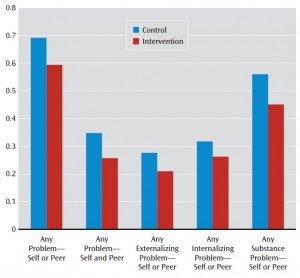One of the “Holy Grails” of psychiatry is the ability not only to treat existing behavioral problems effectively but to prevent them. This task has proven challenging but remains the focus of many given the extraordinary human and financial costs associated with chronic psychopathology and criminal behavior. Some people have become somewhat pessimistic about this goal, especially among at-risk children who at young ages already show signs of early conduct problems and rule-breaking behavior.
One project that has tried to intervene is called the Fast Track prevention program. It began in 1991 as a multi-site effort to test whether comprehensive early intervention could prevent later psychopathology and criminal behavior in a
group identified as at-risk. A total of 979 kindergarteners from 4 geographic areas were identified as showing early conduct problems, based on several rating scales. They were then randomized into a control group and an intervention group designed to increase social competence through skills training, parent behavior management training, peer coaching, and academic support over a period of 10 years. When the subjects were 25 year old, they were reassessed for their arrest records as well as for psychopathology, using standardized rating scales.
As young adults, the rate of a psychiatric or substance abuse diagnosis was 69% in the control group compared to 59% in the intervention group which was a significant difference. This result held for different demographic and severity groups. Significant group differences were also found related to crime, risky sexual behavior, and self-esteem. One key metric was related to arrest and conviction. The incarceration rate was 6.3% for the control group versus 5.0% for the intervention group. While this difference was not statistically significant, there was a significant drop of severity-weighted violent and substance-related crime conviction of 31% and 35%, respectively. Significant effects were not found related to graduation rates or employment. Disappointingly, there was also little effect on how these subjects parented their own offspring.
The study authors concluded that their intervention did result in a significant reduction in psychopathology and criminal behavior. They advocate strongly that prevention efforts can succeed and should be encouraged.
Of note, this program was reported to cost approximately $58,000 per student and future cost analyses are planned. In the discussion, they compare that amount to the estimate that the cost of chronic criminality is 5.3 million dollars per person. The authors point out that one limitation of the study was that they were unable to determine which type of intervention was most protective among the many different types that were tried.
In looking at these data, I have to say that I was both inspired to see a program show clear results but also humbled by what I think many people will find as rather modest results from a fairly intensive and long intervention. It takes an awful lot of work to drop the rate of psychopathology from about 70% to 60% or to reduce the rate of certain types of crime by 30%. This effort seems well worth doing in my view, despite an appreciation for how powerful the forces can be that conspire to keep at-risk children down.
Reference
Conduct Problems Prevention Research Group. Impact of Early Intervention on Psychopathology, Crime, and Well-Being at Age 25. Am J Psychiatry, 2014, epub ahead of print.
Tags: conduct disorder, criminal behavior, fast track, prevention


